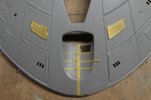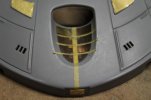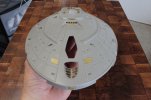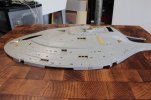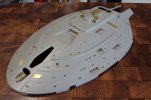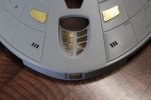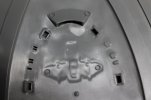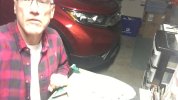Pantherman
Well-Known Member
- Joined
- Feb 10, 2022
- Messages
- 3,691
Great tip for lining up the PE.I'd like to hear more about your own Voyager build Q. Sounds like you had some real fun eh?
Update...
Hobbylinc provided Revell enamel paint tinlets. I write the paint name off the packing slip on the lids using an ink pen.
Most of these are for use on this build.:
View attachment 99897
USS Voyager WIP Img - 017 by Steve J, on Flickr
Showing the tools I used to prepare the bridge module for photo-etch panels by removing the kit molded on detail.:
View attachment 99898
USS Voyager WIP Img - 018 by Steve J, on Flickr
Bridge module after removal of all raised detail on the roof behind the bridge:
View attachment 99899
USS Voyager WIP Img - 019 by Steve J, on Flickr
Light test of some very thin LED strip. This is double density tape and might be a good choice for use in the warp nacelles:
View attachment 99900
USS Voyager WIP Img - 020 by Steve J, on Flickr
Cut the first piece of brass from the ParaGrafix PE sheet. This runs down the center at the back of the bridge module:
View attachment 99901
USS Voyager WIP Img - 021 by Steve J, on Flickr
First piece of photo-etch ready to be glued down with thick (10-25 second) CA.
The tape will hold it in position while I smear glue on the underside before pressing it down:
View attachment 99902
USS Voyager WIP Img - 022 by Steve J, on Flickr
Upper bridge module brass glued in place. I used photos of the Voyager model for help with placement:
View attachment 99903
USS Voyager WIP Img - 023 by Steve J, on Flickr
Missing escape pod hatches - port side:
View attachment 99904
USS Voyager WIP Img - 024 by Steve J, on Flickr
Other side...
Using tape strips makes for perfect alignment:
View attachment 99905
USS Voyager WIP Img - 025 by Steve J, on Flickr
Missing escape pod hatches attached using tape strips for alignment.
I checked CGI and photo references of the studio model and the one door does appear to be curved to match the curvature of the hull:
View attachment 99906
USS Voyager WIP Img - 026 by Steve J, on Flickr
Stay tuned. More photo-etch and drilling fun ahead for all you Voyager fans!
Pantherman


